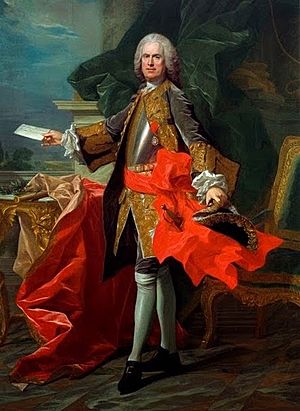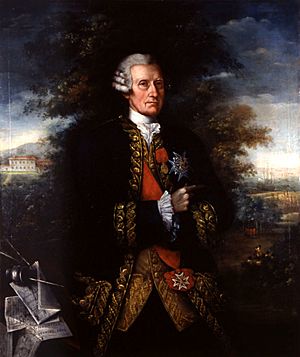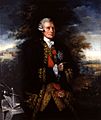Ricardo Wall facts for kids
Quick facts for kids
The Most Excellent
Ricardo Wall
KOS OSL
|
|
|---|---|

Portrait by Jean-Baptiste van Loo (1753)
|
|
| Chief Minister of Spain | |
| In office 15 May 1754 – 9 October 1763 |
|
| Monarch | Ferdinand VI Charles III |
| Preceded by | Fernando de Silva, 12th Duke of Alba |
| Succeeded by | Jerónimo Grimaldi, 1st Duke of Grimaldi |
| Personal details | |
| Born | 5 November 1694 Nantes, France |
| Died | 26 December 1777 |
Ricardo Wall (born November 5, 1694 – died December 26, 1777) was an important figure in Spanish history. He was a Spanish-Irish cavalry officer and diplomat. He rose through the ranks to become the Chief Minister of Spain, similar to a Prime Minister today.
Contents
Early Life and Family Background
Ricardo Wall was born in Nantes, France. His family were Irish Jacobite refugees. This means they supported James II of England, who was the deposed Catholic King of England, Scotland, and Ireland.
Ricardo's father, Matthew Wall, was an officer in King James II's cavalry. The family lived in difficult conditions, supported by a relative. Not much is known about Ricardo's very early years.
Joining the Royal Court
Around 1710, Ricardo became a page for Princess Marie Anne de Bourbon, Duchess of Vendôme. She was a powerful duchess in France. In 1716, he left France to join the Royal House of Spain. This happened after a request from the Spanish Prime Minister, Cardinal Alberoni.
Ricardo Wall's Military Career
Ricardo Wall began his military training at the Colegio Real de Guardiamarinas in Cadiz in 1717. He graduated quickly and joined the Spanish Navy.
Early Battles and Promotions
He served on the ship Real San Felipe during the War of the Quadruple Alliance. This ship was part of the campaign in Sicily in 1718. After the Spanish fleet was defeated, Wall joined the Spanish Regiment of Hibernia. He fought in land battles like Milazzo and Francavilla.
Later, he helped defend Ceuta (1720–21) and was promoted to captain in the Regiment of Batavia.
Diplomatic Missions and European Contacts
In 1727, Wall traveled with James Fitz-James Stuart, 2nd Duke of Berwick to visit the Tsar of Russia. This was an important diplomatic trip. Wall also went on other missions, including to the King of Prussia. The King of Prussia even gave him an award.
These trips helped Wall make many important contacts across Europe. He visited cities like Parma, Vienna, Dresden, and Saint Petersburg. He returned to Spain in 1729.
Further Military Service
Between 1732 and 1734, Wall was part of an expedition to Tuscany. This expedition helped place Prince Carlos on the throne of Parma. Soon after, he fought in the War of Naples (1734–35). He saw action in places like Capua and Messina.
In 1737, he was made a Knight of the Order of Santiago. This was a very respected military honor. In 1741, he became a Commander of Peñausende.
In 1740, he was appointed Colonel of Dragoons. His regiment proudly displayed his family motto: Aut Caesar aut nullus (meaning "Either Caesar or nothing").
Rising Through the Ranks
Wall became a Captain-General in 1744. He fought in the Lombardy campaign during the War of the Austrian Succession. He was known for his bravery in attacks. In 1747, he was promoted to Brigadier. During this time, he became good friends with the Duke of Huéscar, a very influential person at court.
After being wounded in battle in 1746, he moved into diplomatic service. In 1747, he was sent on a mission to Genoa. Soon after, he was posted to London by the Spanish Minister of State, José de Carvajal.
Ambassador in London
Ricardo Wall's main job as ambassador in London was to negotiate peace between the Spanish and British royal families. However, his mission faced challenges. Some British officials were unsure about him because of his Irish background. There was also some conflict within the Spanish government.
Wall eventually settled into his role as ambassador. He lived in Soho Square and supported the arts. He commissioned a painting by Tiépolo for his private chapel. He also supported writers like Tobias Smollett, who dedicated his translation of Don Quixote to Wall.
Ricardo Wall as Chief Minister of Spain
In 1754, Wall was called back to Madrid. He became the Minister of Foreign Affairs after the death of José de Carvajal. A few months later, he played a role in removing the previous minister, the Marquess de La Ensenada, from office.
Wall served as Chief Minister until 1763. He was then replaced by the Duke of Grimaldi.
Working for Peace
Even though he was Irish, Wall was a strong supporter of peace and good relations with Britain. He often complained to British officials about problems caused by British privateers (private ships authorized to attack enemy ships) in Spanish waters.
Wall was also concerned that Britain's new colonies from France could threaten Spain's own South American Empire. When King Charles III came to power in 1759, he kept Wall as Prime Minister.
War and Retirement
In 1761, Spain declared war. As Prime Minister, Wall had to carry out the King's decision. However, he later told the British Ambassador that he regretted not being able to keep the peace. The close ties between King Charles III and the French Kings made Wall's job very difficult.
King Charles did not like to change his ministers. He refused Wall's requests to retire. Finally, in 1763, Wall pretended to have an eye disease to convince the King to let him retire.
Throughout his time in government, Wall built a strong network of relationships. These connections helped Spain even after he left office. He worked with many important people, including other ministers and ambassadors from across Europe. He also had many Irish supporters, such as engineers and military officers.
Wall was elected a Fellow of the Royal Society in 1753. This is a very prestigious scientific organization.
Retirement Years
The King of Spain gave Ricardo Wall a generous reward for his service. He received a large piece of crown land called the Soto de Roma, near Granada. This land was later given to other important figures, including the Duke of Wellington.
General Wall spent the rest of his life, until 1777, living between homes near Alhama de Almeria and Granada. He welcomed visitors, especially English travelers who were exploring Spanish culture. He was known as a very capable minister and a witty person to talk to.
He passed away on December 26, 1777. Ricardo Wall never married and had no children. His closest relative was his cousin, Eduardo Wall.
Images for kids
-
Portrait by Jean-Baptiste van Loo (1753)
See also
 In Spanish: Ricardo Wall para niños
In Spanish: Ricardo Wall para niños
- List of prime ministers of Spain
- Marquesado de La Cañada
- Condado de Sástago
- Casa de Manrique de Lara






